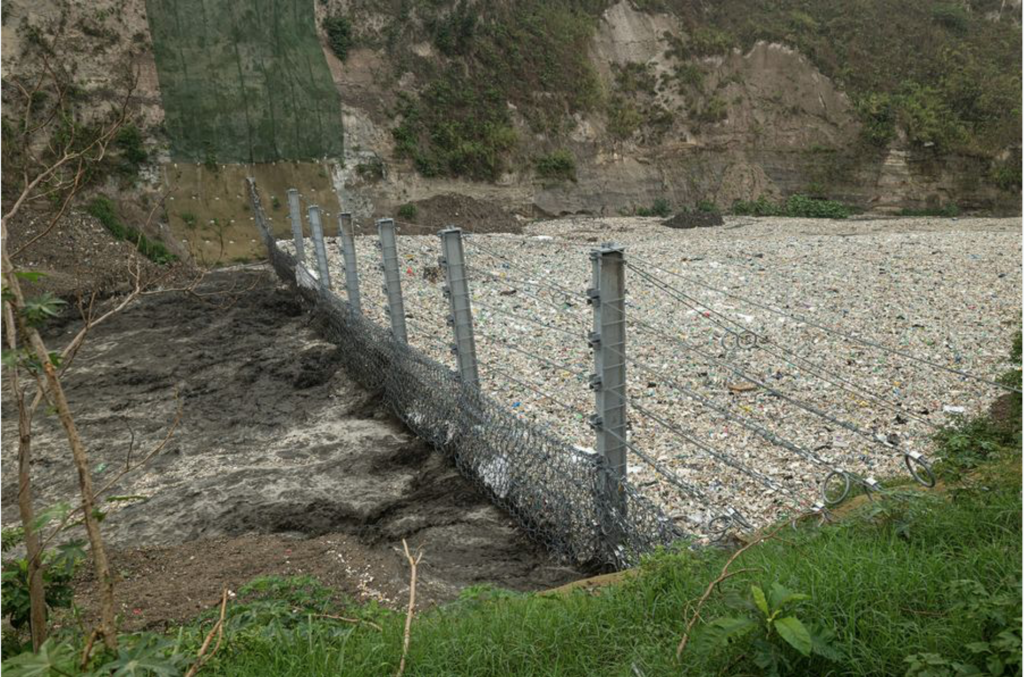“At The Ocean Cleanup, our mission is to rid the oceans of plastic”. Ocean plastic pollution is a global emergency requiring immediate action, which starts by rapidly cutting the massive yearly inflows of plastic into the oceans from rivers.
“We deploy our Interceptors in some of the highest polluting rivers on Earth, providing practical and innovative ways to stop plastic reaching the seas and keep our oceans clean in areas where we can have maximum impact.” said The Ocean Cleanup’s representative.
2022 saw The Ocean Cleanup’s first attempt to stop the trash tsunamis flowing from Guatemala’s Rio Las Vacas into the Rio Motagua and from there into the Caribbean Sea. For this, they trialed the Interceptor Trashfence: an 8 meter high fence that was designed to let water pass but block the trash.
Despite initially holding back the tons of waste rushing downstream, the trial was unsuccessful and most of the trash was lost. “Now deploying a new type of Interceptor in an attempt to finish the job we started one year ago”.
This river presents challenges like no other. If successful, we believe this project will have a major impact on ocean plastic pollution in the Gulf of Honduras, and contribute to cleaner and healthier waters for Guatemala and the wider international region.
The Rio Motagua
The Rio Motagua is Guatemala’s largest river, and suffers a variety of circumstances and challenges that have resulted in a significant source of plastic pollution into the ocean from within and around Guatemala City.
The Rio Las Vacas, a tributary of the Rio Motagua, is located close to Guatemala City – a sprawling and growing community of one million people. Like many populous cities in the region, Guatemala City faces challenges in the development of waste management and sanitation systems, particularly in response to extreme weather events. Every year, seasonal rains cause flash floods which bring massive amounts of trash through the Rio Las Vacas, into the Rio Motagua, and on to the open sea.
Plastic pollution on the river bed of Rio Las Vacas
The typical challenges of waste management are exacerbated by illegal dumping – plastic and other waste disposed of directly into the river both in Guatemala City itself and in other regions. Local authorities are committed to addressing these issues through a range of initiatives, but these solutions require time to implement successfully – while each year the tsunamis of trash continue to spew into the ocean.
The First Encounter
In 2022, The Ocean Cleanup trialed the experimental Interceptor Trashfence in the Rio Las Vacas.
“Our initial trial with the Interceptor Trashfence was unsuccessful because the composition of trash in the river meant that once the river met the fence, the water flow was impeded to a greater degree than anticipated. As the water wasn’t flowing through the fence as freely as anticipated, this caused the water to be pushed downwards towards the foundations of the fence, causing rapid erosion of the riverbed around these foundations. The erosion damage caused the fence to give way under the massive forces of the flooding water and tons of trash.”

The new Interceptor Barricade is a system of extremely heavy duty floating booms placed throughout the river to efficiently capture plastic, while allowing the water to pass freely below the surface.
The Rio Las Vacas river in Guatemala
The Interceptor Barricade is placed in a hydropower reservoir lake, in the Rio Las Vacas close to the city of Chinautla, around 16 km north of Guatemala City.
Because the flow speed here is expected to be lower than at the original location (500 meters further upstream), pressures on the system will be lessened. To design and construct the Interceptor Barricade, The Ocean Cleanup collaborated with Worthington Products, a US-based company specializing in river debris control solutions.
Global Challenges, Local Partners
Through their support of The Ocean Cleanup and Interceptor 006, the Municipality of Guatemala City have shown their commitment to taking meaningful action on plastic pollution in the Rio Motagua, as part of their wider initiative to protect the environment in and around Guatemala City. The Ocean Cleanup will also be exploring ways to work together to prevent further plastic from entering the river in the first place.
“Our collaborators in Guatemala are also vital for managing the trash we intercept. After the trash has been removed from the Interceptor Barricade (using excavators operated from the shore) it will be weighed on-site to determine the total catch quantities; as with all our deployments these quantities will be verified in collaboration with DNV.”
The plastic catch then passes to local partners and waste management authorities. “In collaboration with Guatemalan NGO BiosferaGT (with the support of The Coca-Cola Company) we have set up a waste sorting center staffed by members of the local community to trial recycling operations for some of our extracted waste. Should this trial prove successful we will look to scale up this scheme.”
“Ridding the oceans of plastic is an ambitious goal, and The Ocean Cleanup can’t do it alone. We hope to continue working on plastic pollution in Guatemala by expanding our operations across the country, working with both municipal and national government to address any remaining leakage to the ocean.”
Finish What We Started
“We came to Guatemala to help prevent an environmental emergency that causes devastation to the marine environment and has serious impacts in the local area and beyond. That ambition has not changed.”
The most efficient way to clean our oceans is to prevent plastic entering the oceans in the first place, and the most impactful way to do this is to provide interception solutions in areas with the highest levels of plastic leakage into the ocean.